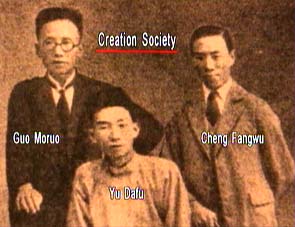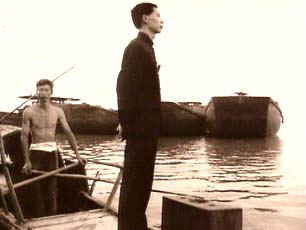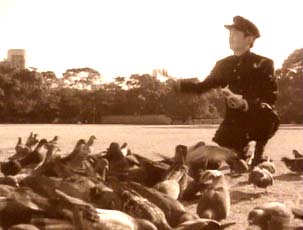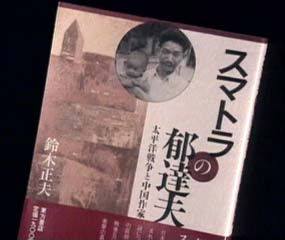 Yu Dafu passed away more than 50 years ago. He and Lu Xun participated in the initiating of the Great League of Freedom Movement in China which had an important function of promoting and developing a prosperous Chinese new literature. Yu Dafu passed away more than 50 years ago. He and Lu Xun participated in the initiating of the Great League of Freedom Movement in China which had an important function of promoting and developing a prosperous Chinese new literature.
Shanghai, a metropolitan then, was the place where Yu Dafu became famous in the literary circle. Guided by the scholar Chen Zishan, a man familiar with the old Shanghai, we started to look for the exclamations and questions of Yu Dafu's life's journey.
In 1927, Yu Dafu began to host a literary society "Creation Society" and became the chief editor of the magazines.
Yu Dafu was born on Dec. 7, 1896 in Fuyang, Zhejiang province. His grandfather and father were famous doctors in this small city by the side of Fuchun River. So, he was from a scholars' family. Until now, there are still families of the Yus living here. This rebuilt brick house is located at the former site of a small wooden house where Yu Dafu lived here once.
It was during the years at the turn of the new and old educational systems when Yu Dafu was a pupil. He studied in the old style private school and the new public county primary school. In 1911, the 15-year old Yu Dafu left his family and went to study in Hangzhou.
 When he went back home to carried out self-taught study, he didn't isolate himself from the society. He had already cast his look at the outside world.
When he went back home to carried out self-taught study, he didn't isolate himself from the society. He had already cast his look at the outside world.
In Yu's autobiography, he said, "The two years' study made me end up my homesickness." In Sept. 1913, his elder brother Yu Mantuo went to Japan to study judicial affairs. So, Yu Dafu decided to go with his brother to study in Japan. Since then, he left his hometown for ever. Although he went back home to get married or to take refuge at home, yet spiritually, he had never returned home since then.
Yu Dafu studied in Japan for 10 years. He was deeply influenced by the Japanese culture in his daily life and creative works. He loved Japan, yet he expressed his 'hatred' in his works. In recent years, those intellectuals who went to study in Japan, had also such feelings of love as well as hatred.
In Sept. 1915, Yu Dafu went to Nagoya to study Medicine in the 8th High School. That was an important period of his staying in Japan.
There are several words chiseled on a tablet of a student figure in the 8th High: "My Friends, Travelers of Youthfulness". It revealed perfectly their romantic feelings.
 Tanpu Hattori was a famous landlord in Yatomio village in the suburb of Nagoya. He began to write Han poems when he was 14 years old. He had hosted many poets' clubs in the past. In May 1916, Yu Dafu met him and often went to visit him.
Tanpu Hattori was a famous landlord in Yatomio village in the suburb of Nagoya. He began to write Han poems when he was 14 years old. He had hosted many poets' clubs in the past. In May 1916, Yu Dafu met him and often went to visit him.
Today's Hattori family was a declining family. Shopu Hattori, Tanpu Hattori's grandson, is now teaching Han poems as his career. Though he had never seen Yu Dafu before, he knew well about Yu Dafu's situation when Yu came to Qi Bridge to ask for the way to his home. This bridge was mentioned in Yu's poem given to Tanpu Hattori.
Shoji Ineha, a scholar who had studied Yu Dafu's novels when he was a young man, had written a book. Shoji Ineha was brought up in Nagoya, so he had an advantage to investigate Yu Dafu's past story when he was living in Nagoya. In Shoji Ineha's materials, there was some ignored information about Yu Dafu in the study related to Yu Dafu.
In our knowledge about him, Yu Dafu's image was rather complicated. In Nov. 1919, Yu Dafu entered Tokyo U. to study economics.
According to a librarian of Tokyo U., he recalled that no man could surpass Yu Dafu in reading novels when he was working in the library. At that time, Yu Dafu had already mastered three foreign languages, English, Japanese and German.
 From 1913 to 1922, during the ten years of Yu Dafu's study in Japan, although the pressure of his study was not very high and his economic situation was not bad, he had lived a romantic yet dispirited life. Besides drinking wine and writing poems, he would go to visit the red light districts to seek stimulation. Shoji Ineha followed the route of Yu Dafu's life in the red light district in Nagoya according to Yu Dafu's famous novels.
From 1913 to 1922, during the ten years of Yu Dafu's study in Japan, although the pressure of his study was not very high and his economic situation was not bad, he had lived a romantic yet dispirited life. Besides drinking wine and writing poems, he would go to visit the red light districts to seek stimulation. Shoji Ineha followed the route of Yu Dafu's life in the red light district in Nagoya according to Yu Dafu's famous novels.
“I stepped on the train of Tokaido Line to Tokyo in the afternoon when it was still snowing. In the cold wind and a day's snow, after I drank several bottles of wine, it made my blood temperature rise a few degrees. I stepped out of the train station and jumped into a jinrickshaw. I wrapped my face with my scarf and shouted loudly at the ricksha man to take me direct to a whore veranda. I selected a stout young whore. I stayed there late at night, singing and drinking and I gave up my chastity.”
Yu Dafu started to reveal himself when he returned Shanghai from Japan. He tried bravely to dissect himself by describing his own sex life. When his articles were published, they were greatly appreciated by the young people.
In Jan. 1927, Yu Dafu met a girl called Wang Yingxia. Then, on July 5, they were engaged by setting a feast to treat their friends. Decades later, there were still many old buildings kept untouched. In one of the old stone-framed gates, we could find that old house where Yu Dafu and Wang Yingxia lived together. Its present house number is #92 Minhou South Lane.
 The war and their trouble in love made Yu Dafu consider to change the condition of their livelihood. He decided to move their home to Singapore. To drive himself from his homeland was his fringe policy which he had always advocated.
The war and their trouble in love made Yu Dafu consider to change the condition of their livelihood. He decided to move their home to Singapore. To drive himself from his homeland was his fringe policy which he had always advocated.
Unfortunately, when he reached the final stage of their remote livelihood, he had lost his life and failed to fulfill it.
By the end of 1938, Yu Dafu brought Wang Yingxia and his son, Yu Fei, to Singapore through the Clifford Pier. Later, they also fled through this pier to Indonesia.
On Jan. 1, 1939, Yu Dafu became the editor of the morning and evening supplements. When he settled down in Singapore, he didn't write any novels. He only wrote current events survey. And at the same time, he took up the role of training people to take up writing.
At first, Yu Dafu wanted to live with Wang Yingxia in Southeast Asia the rest of their life. But he failed to let her come back to him. Wang Yingxia went back to China alone.
 In Sumatra, many of his friends could recognize that little boss Zhao Lian with a mustache who could speak Indonesian. Fearing he might be discovered by the Japanese gendarme, Yu Dafu kept his identity hidden. Later he got married with an oversea Chinese called He Liyou.
In Sumatra, many of his friends could recognize that little boss Zhao Lian with a mustache who could speak Indonesian. Fearing he might be discovered by the Japanese gendarme, Yu Dafu kept his identity hidden. Later he got married with an oversea Chinese called He Liyou.
Because he knew Japanese very well, he was hired by the headquarters of Japanese gendarme in Bukit Tinggi. That's why he was killed later on.
In 1968, a Japanese scholar Susuki Masao came to Indonesia trying to uncover the historical mystery about Yu Dafu's death. He secretly went to see that squad leader of the Japanese gendarme who secretly sent out the order to kill Yu Dafu. At that night, he was taken away by the Japanese gendarme and was strangled to death later.
|